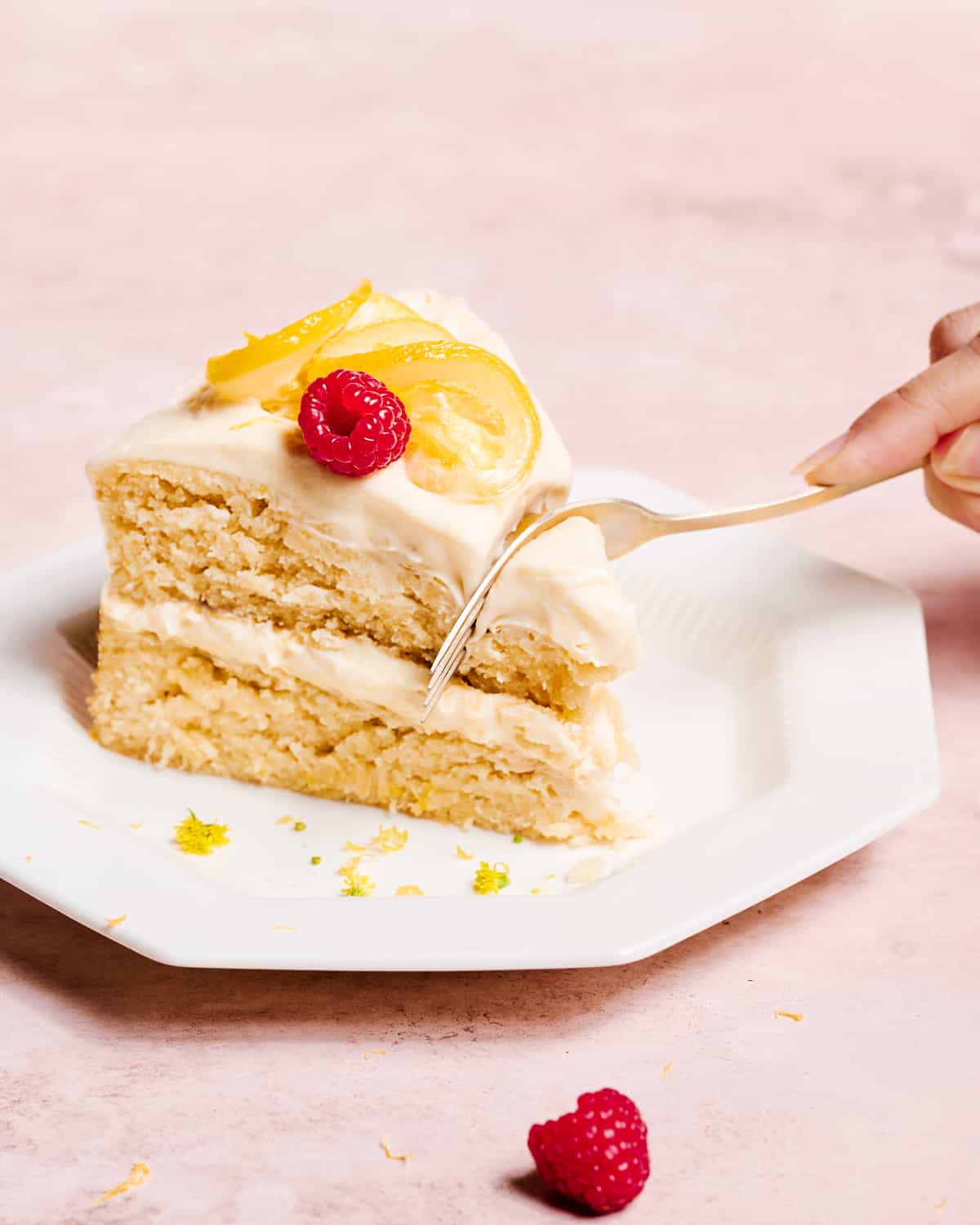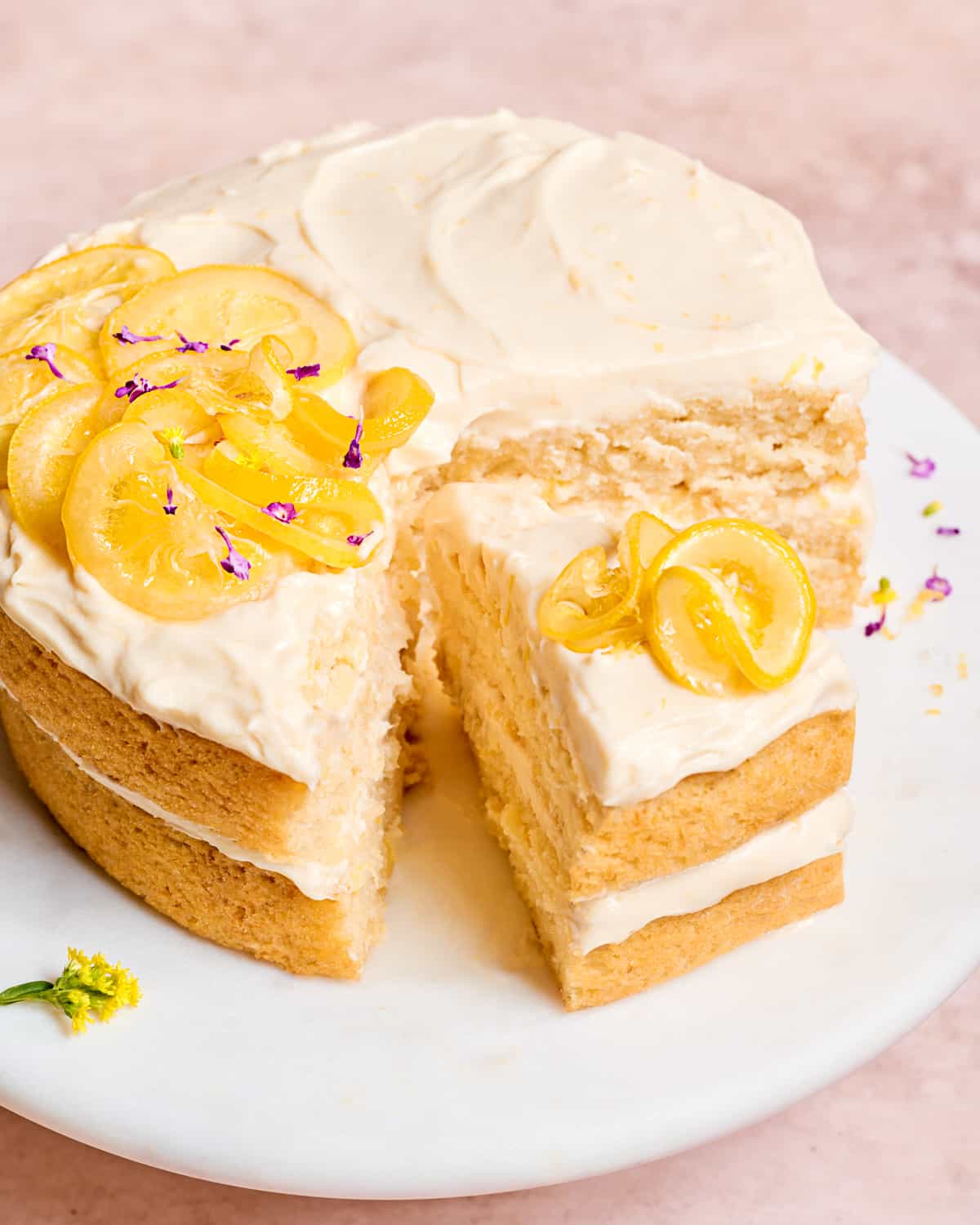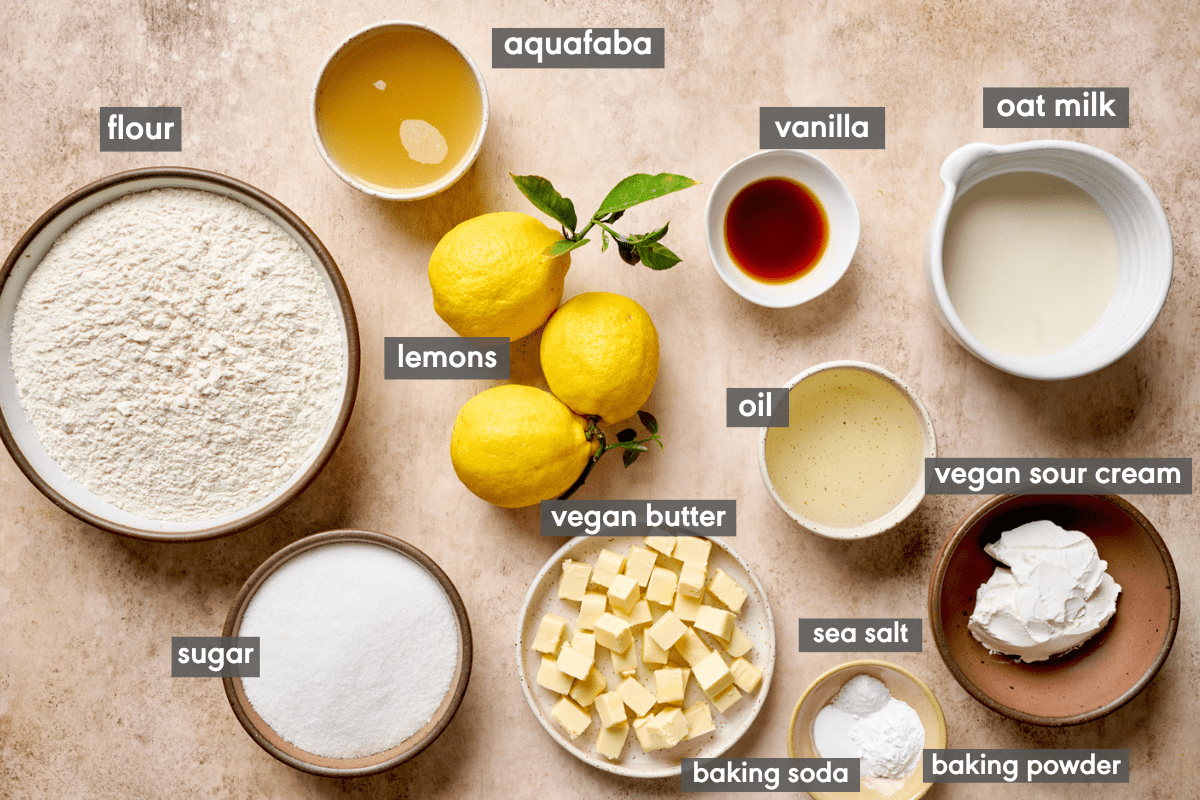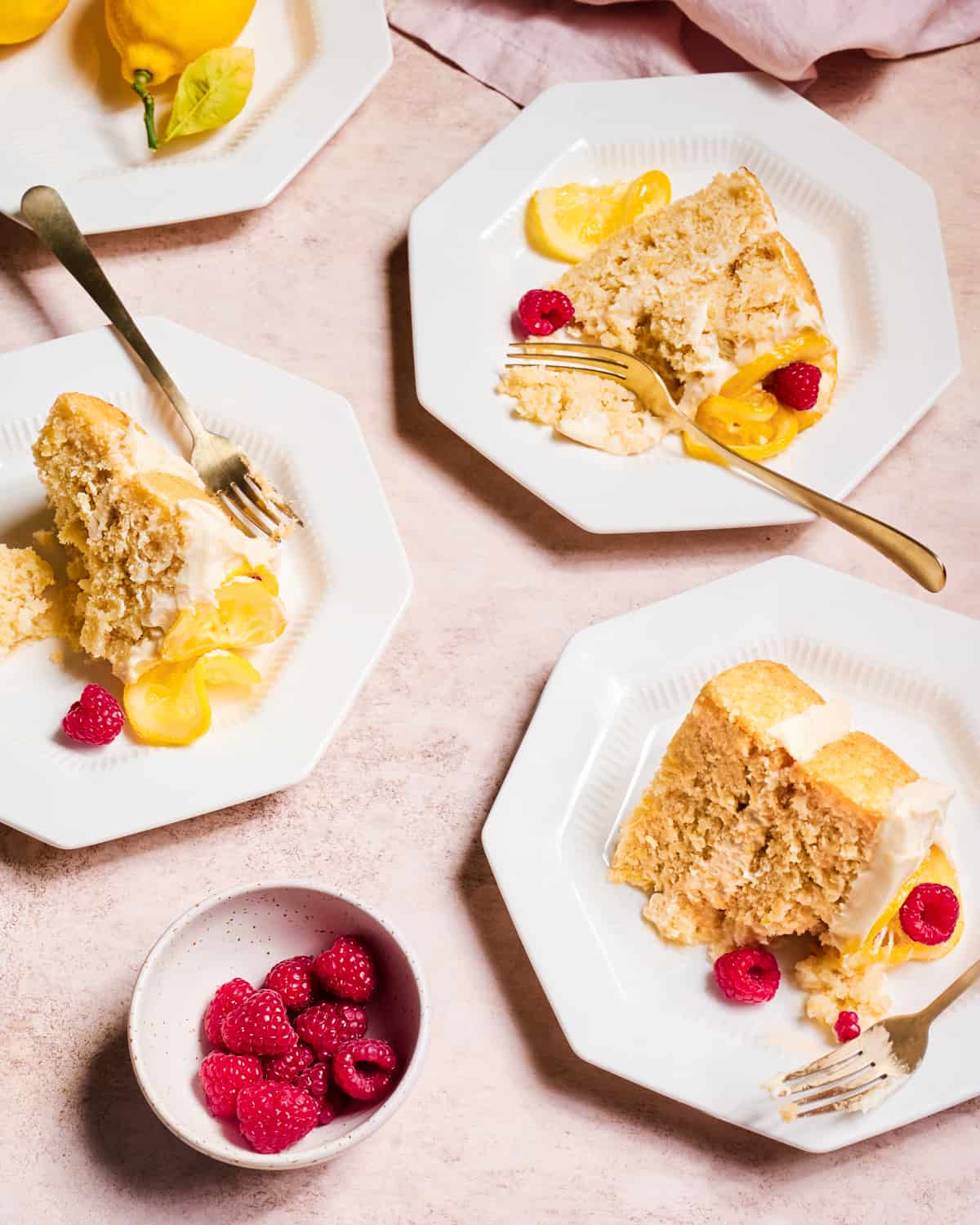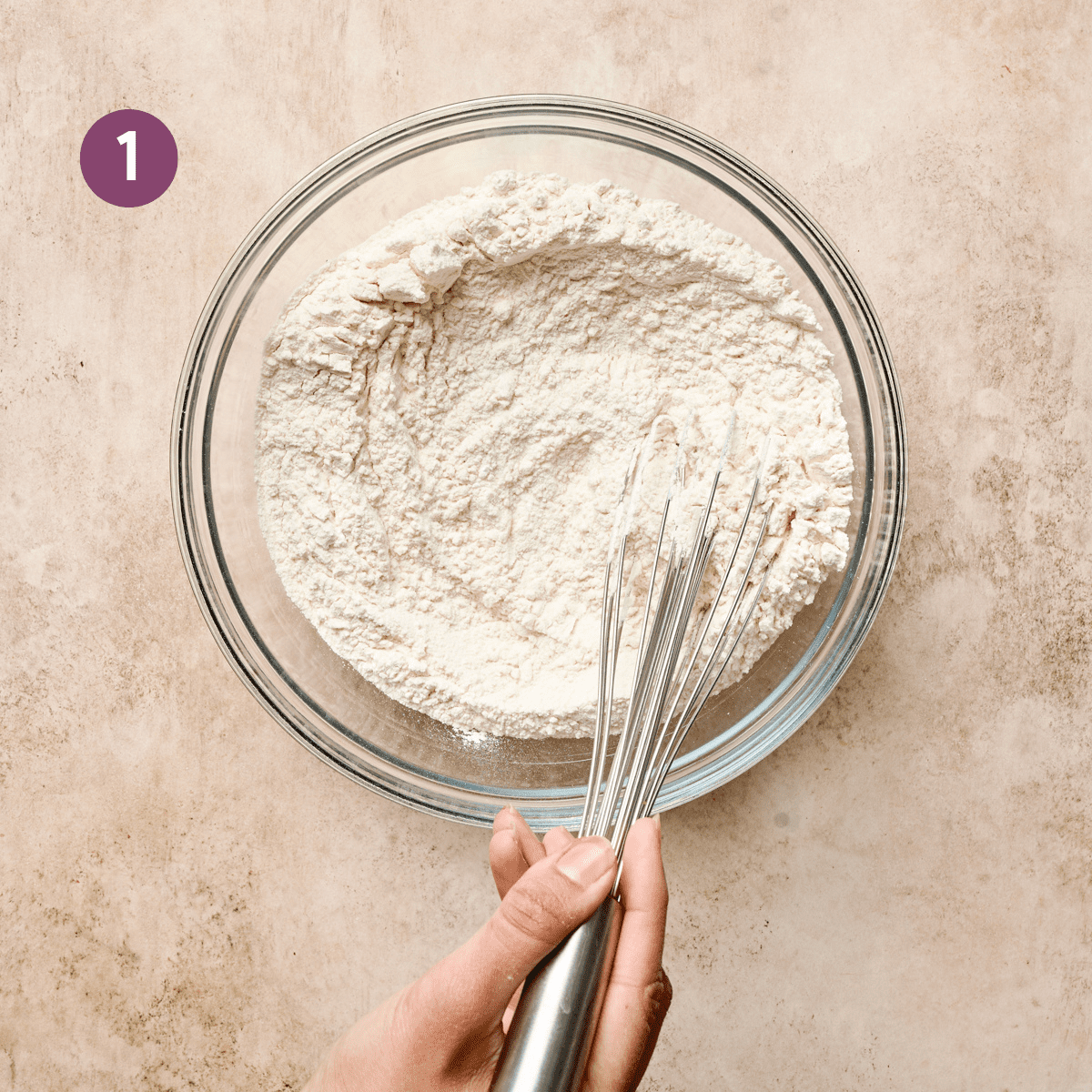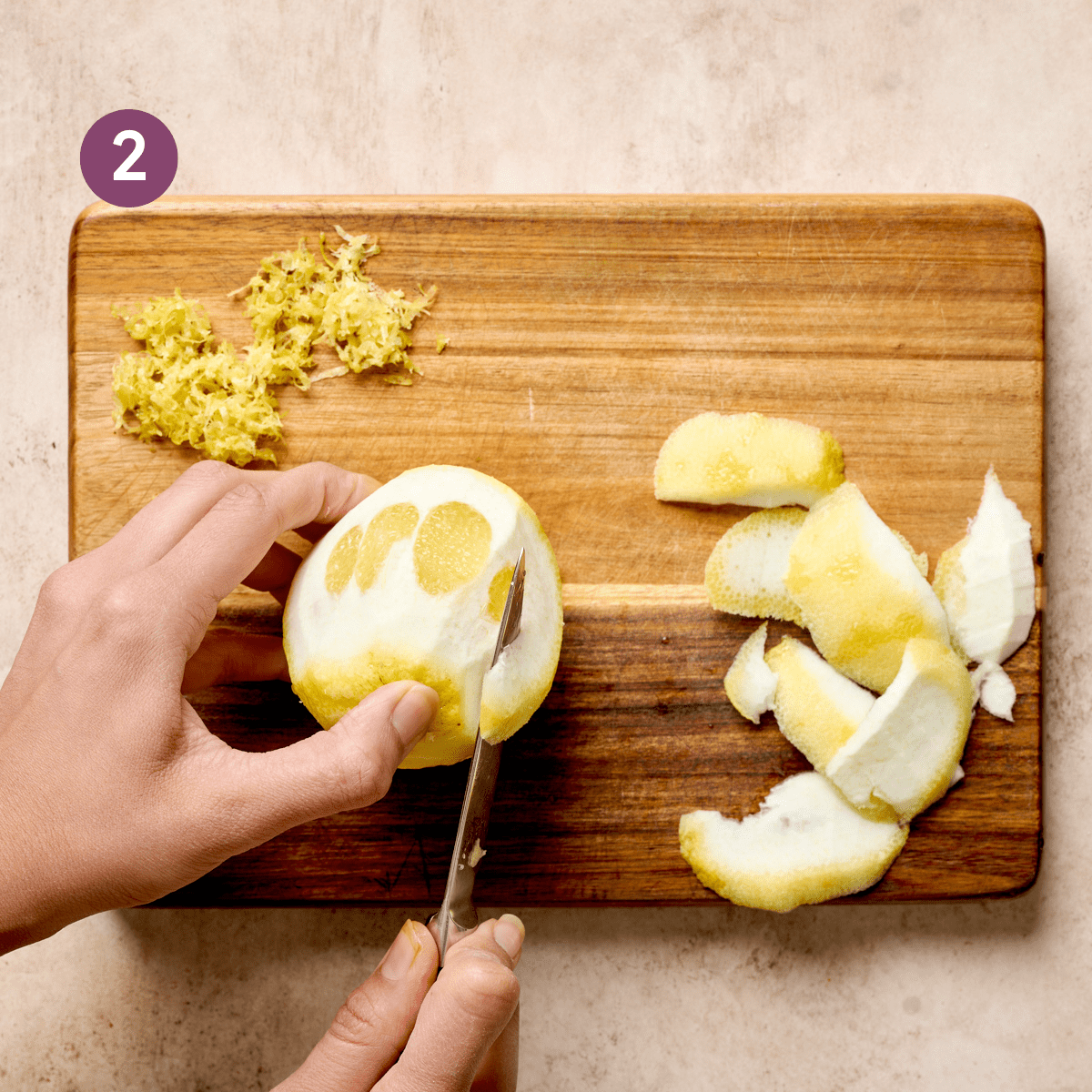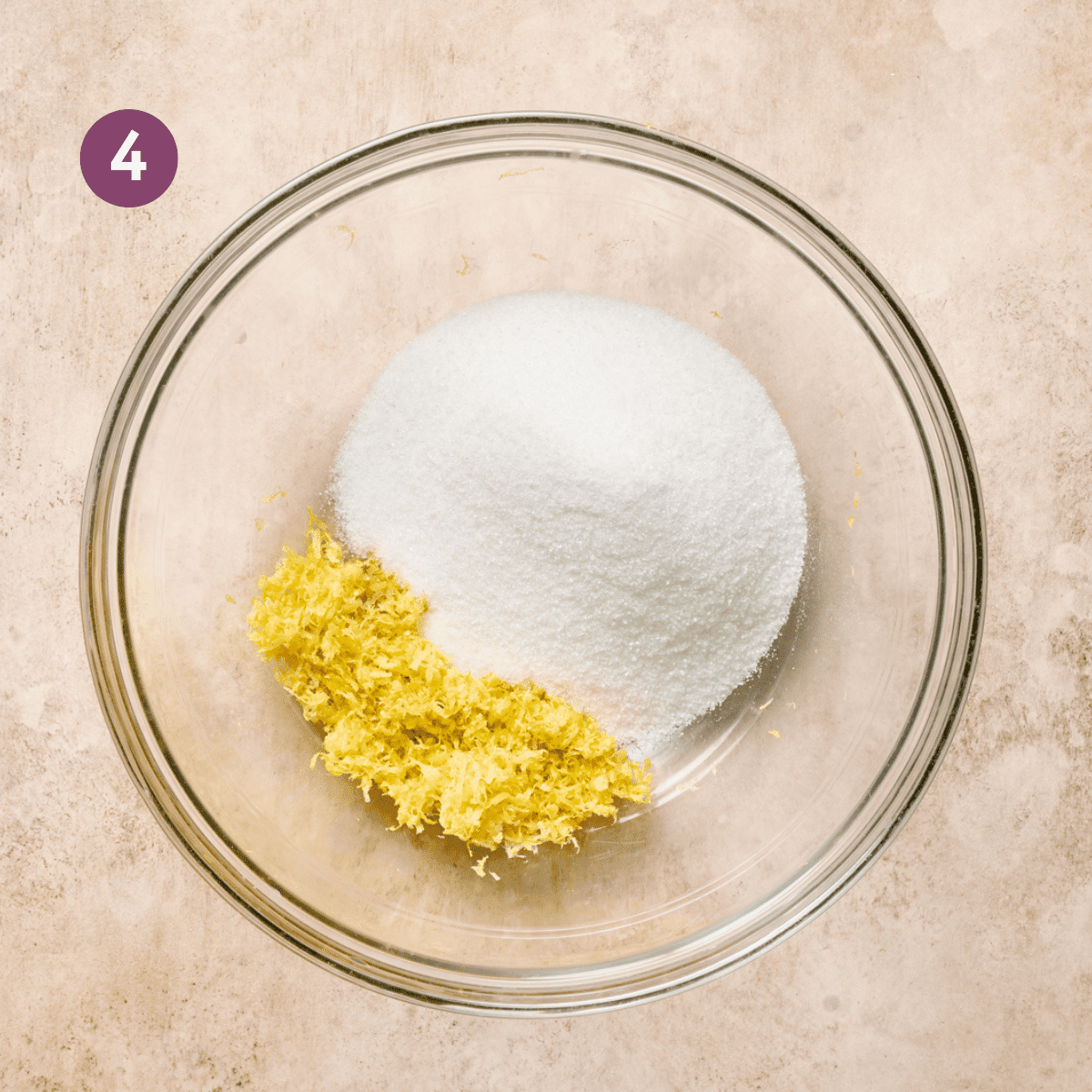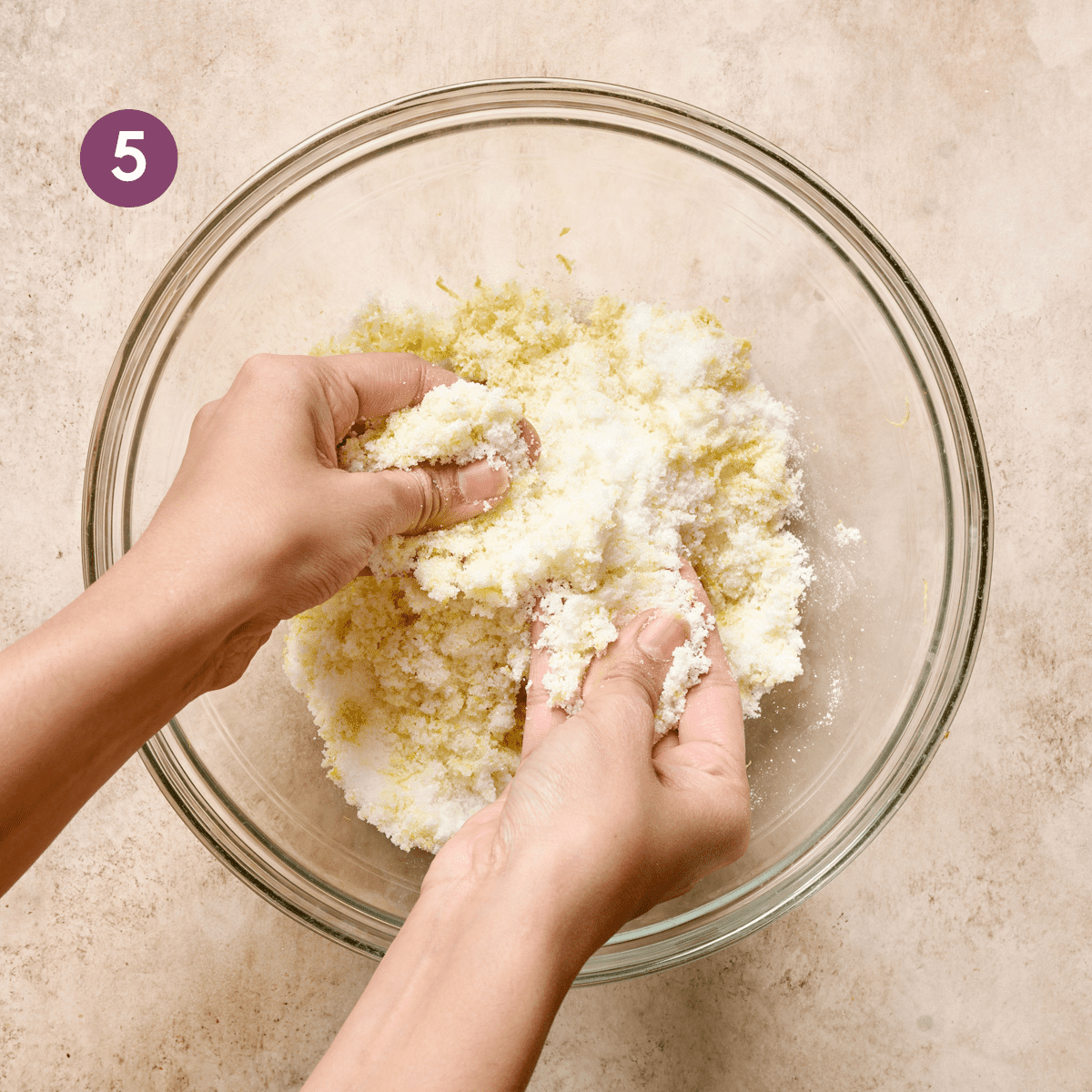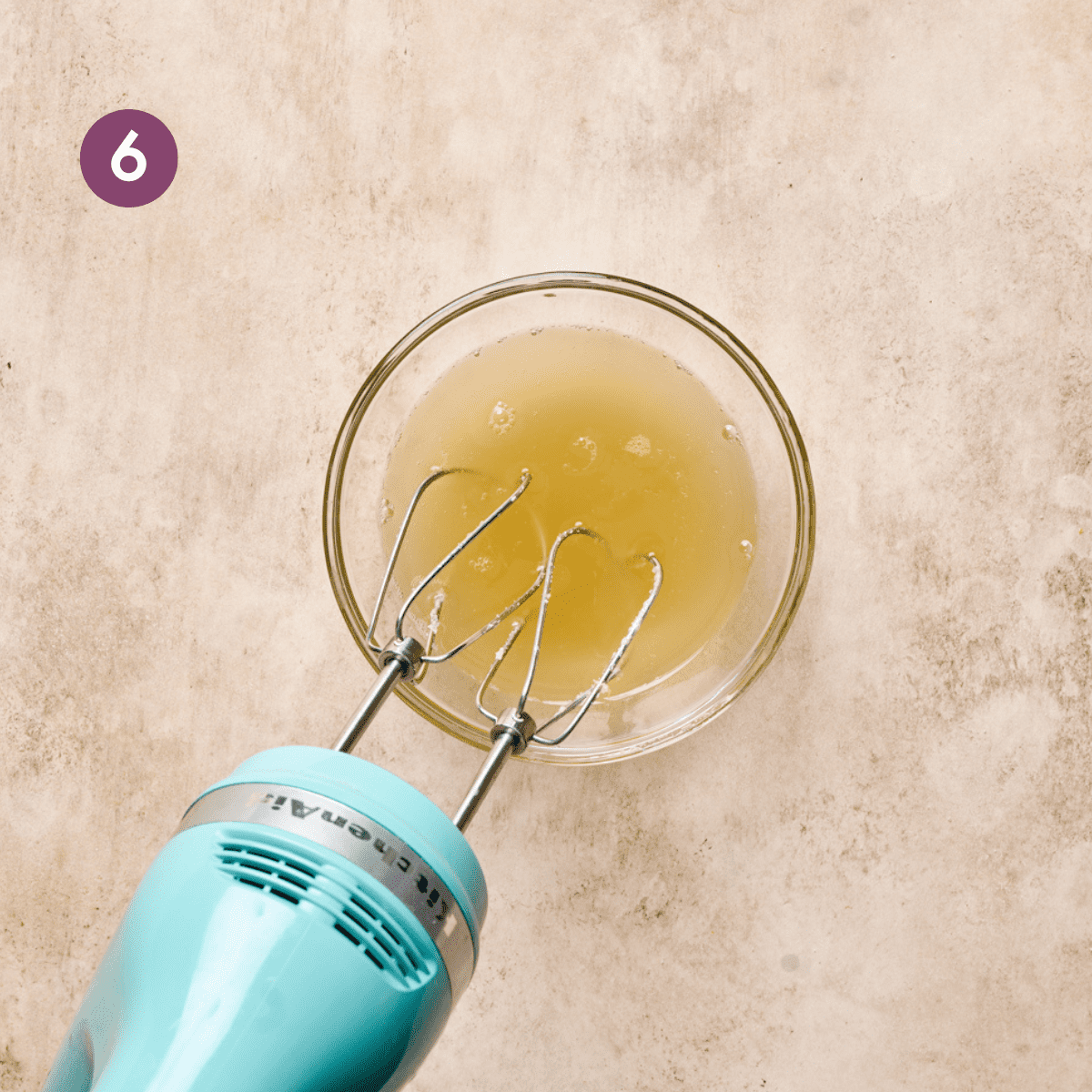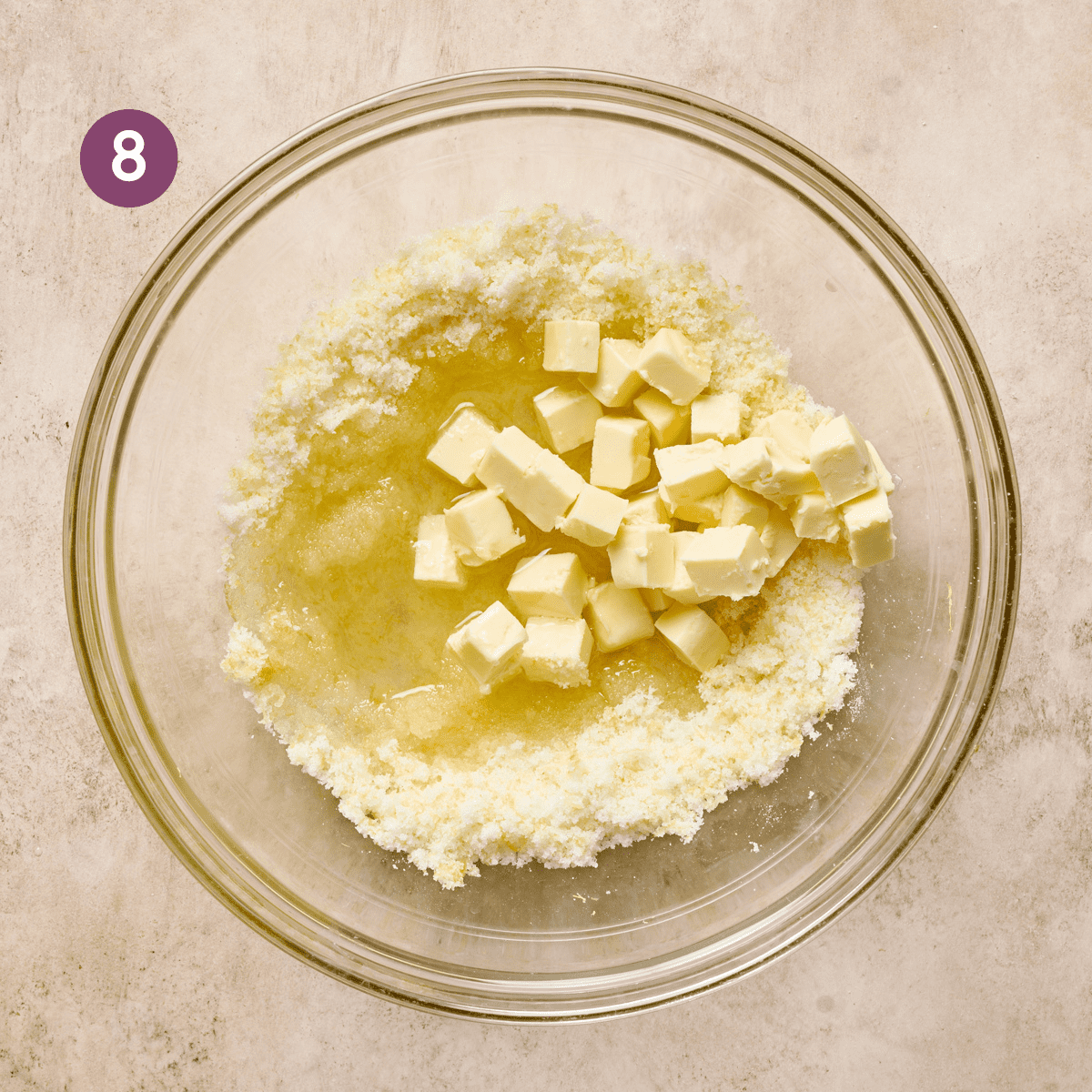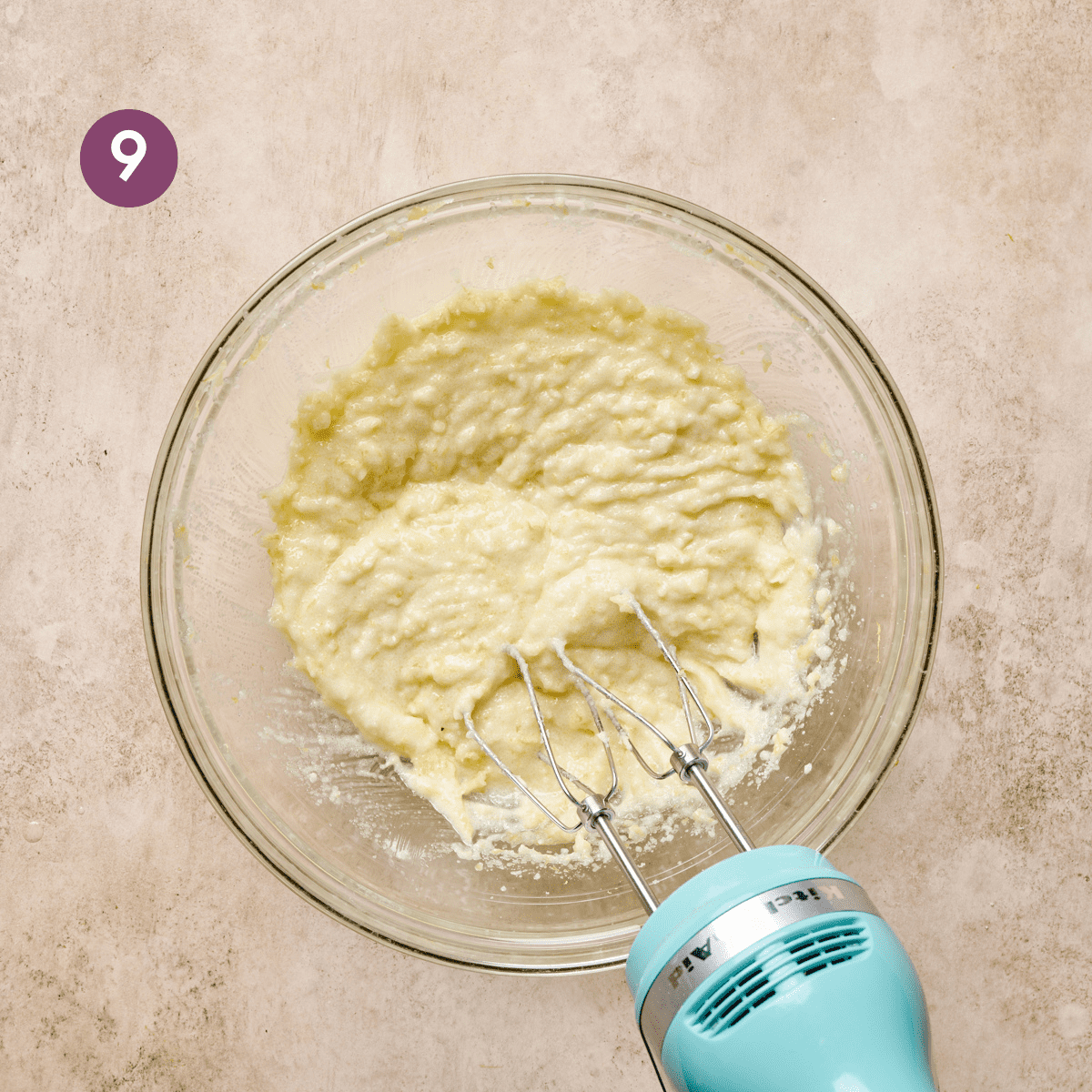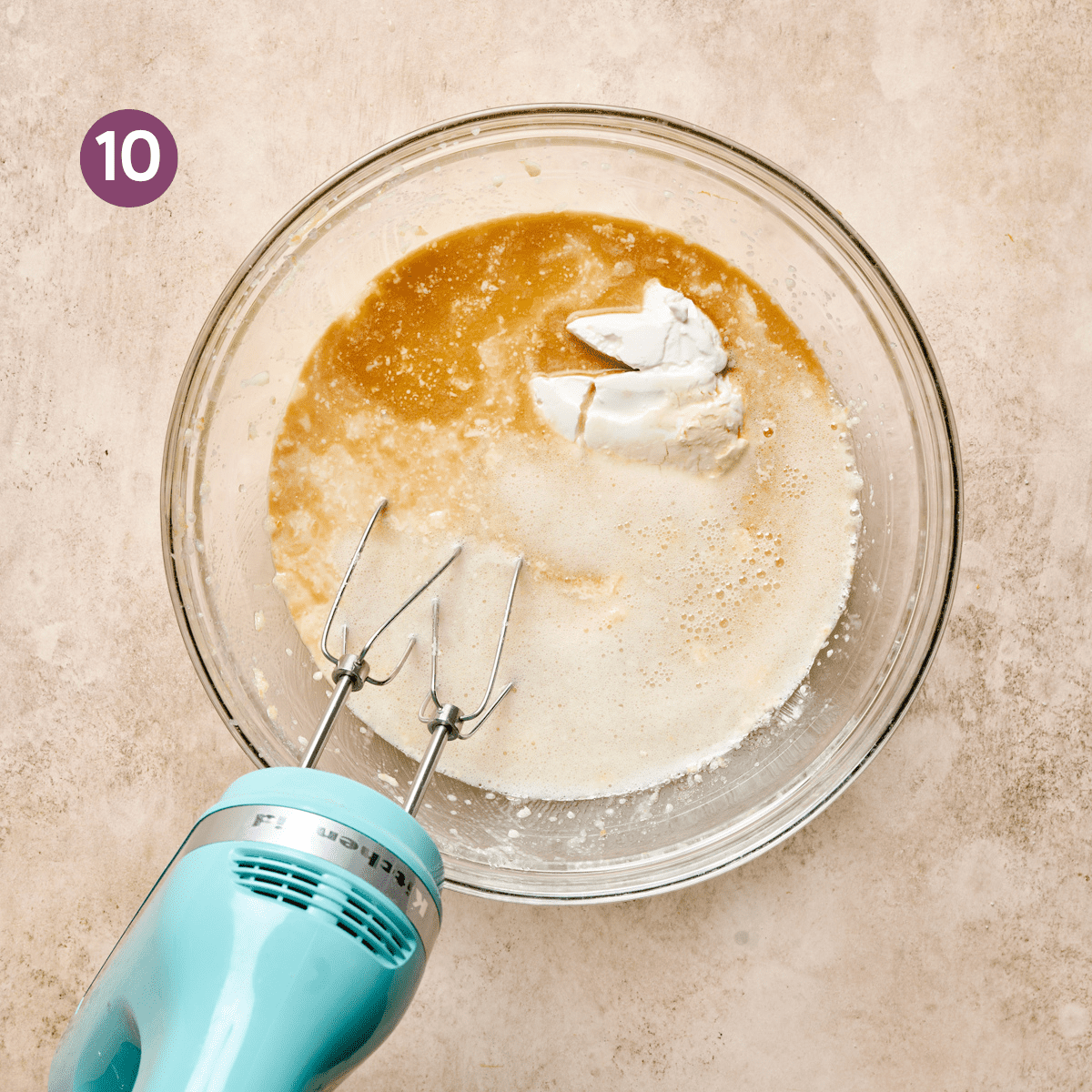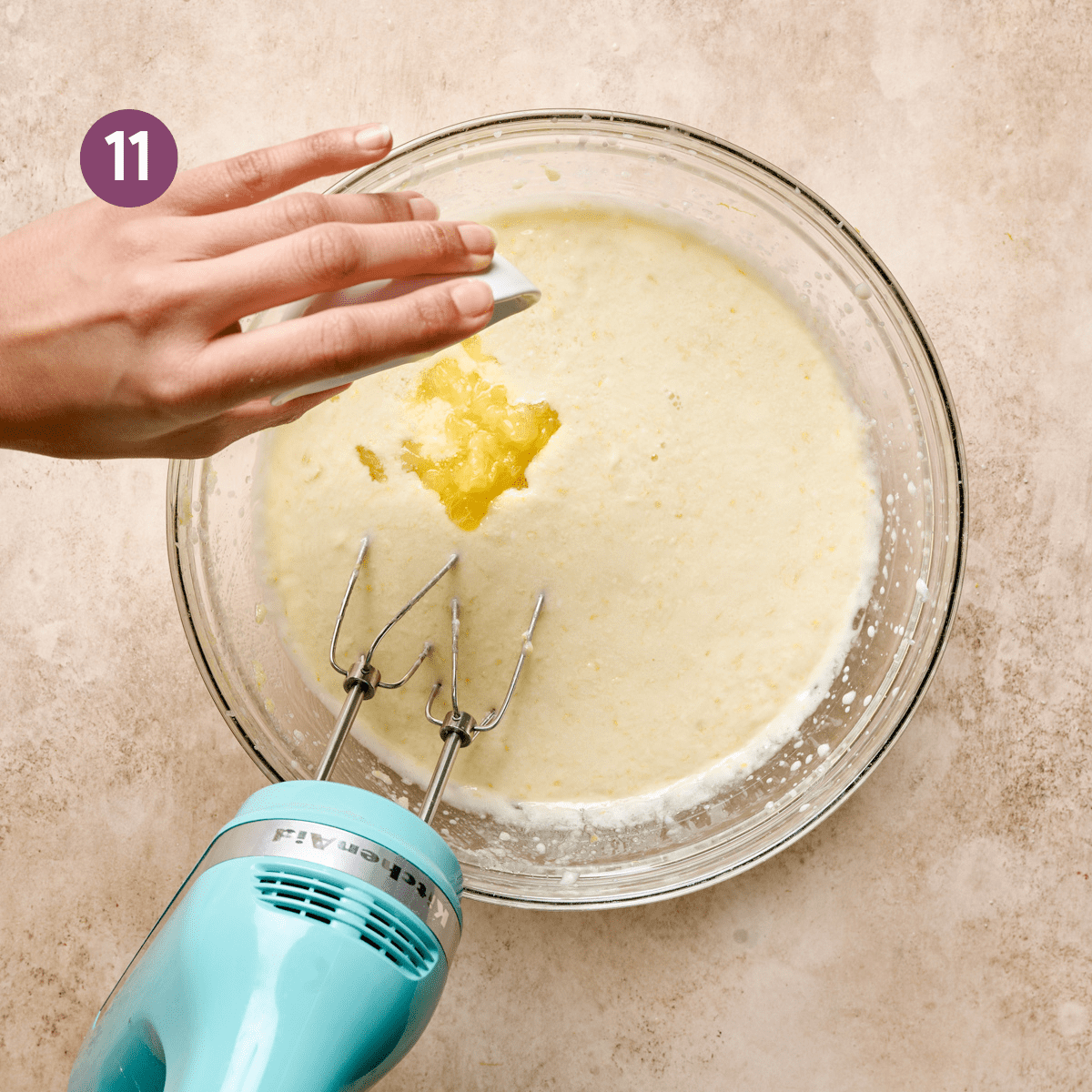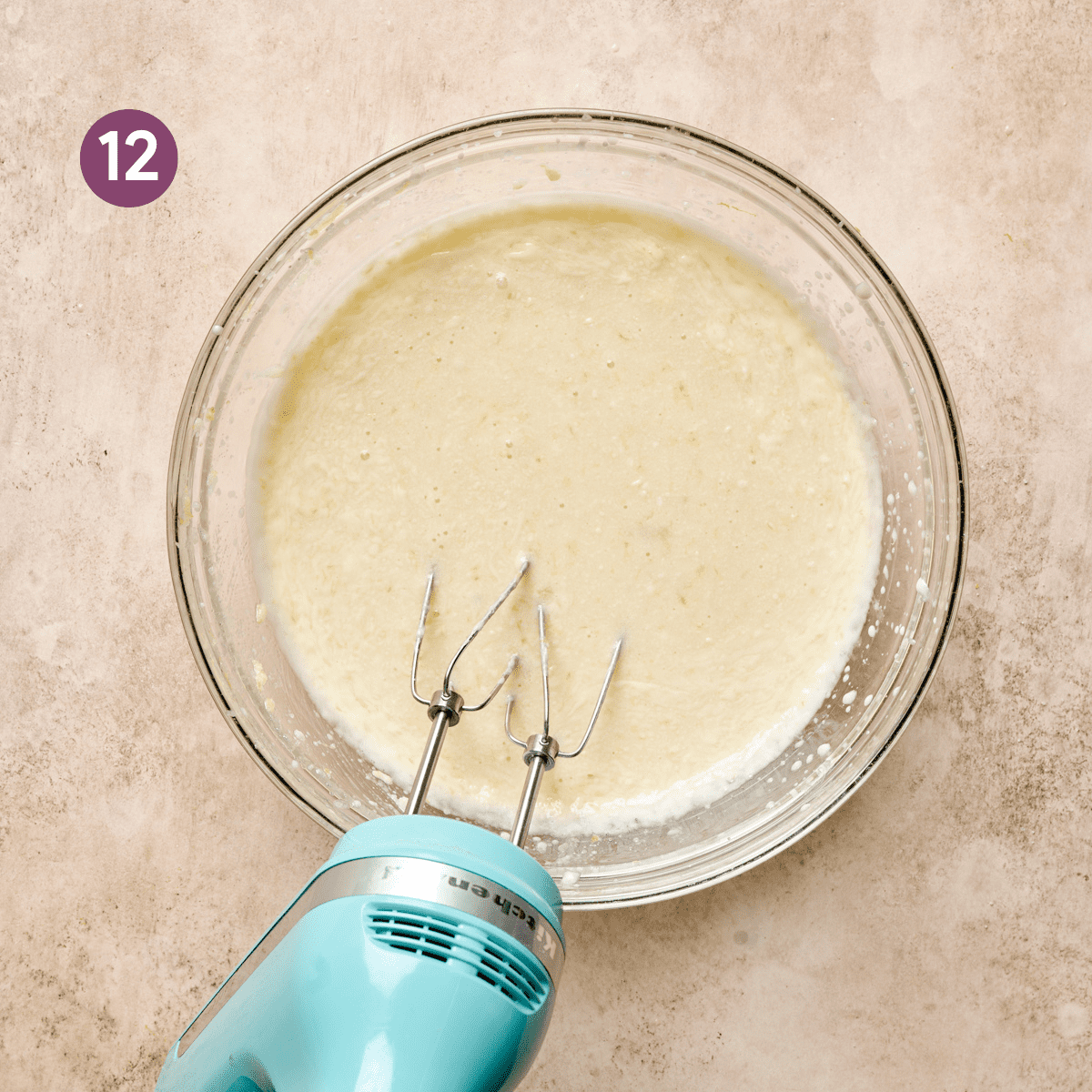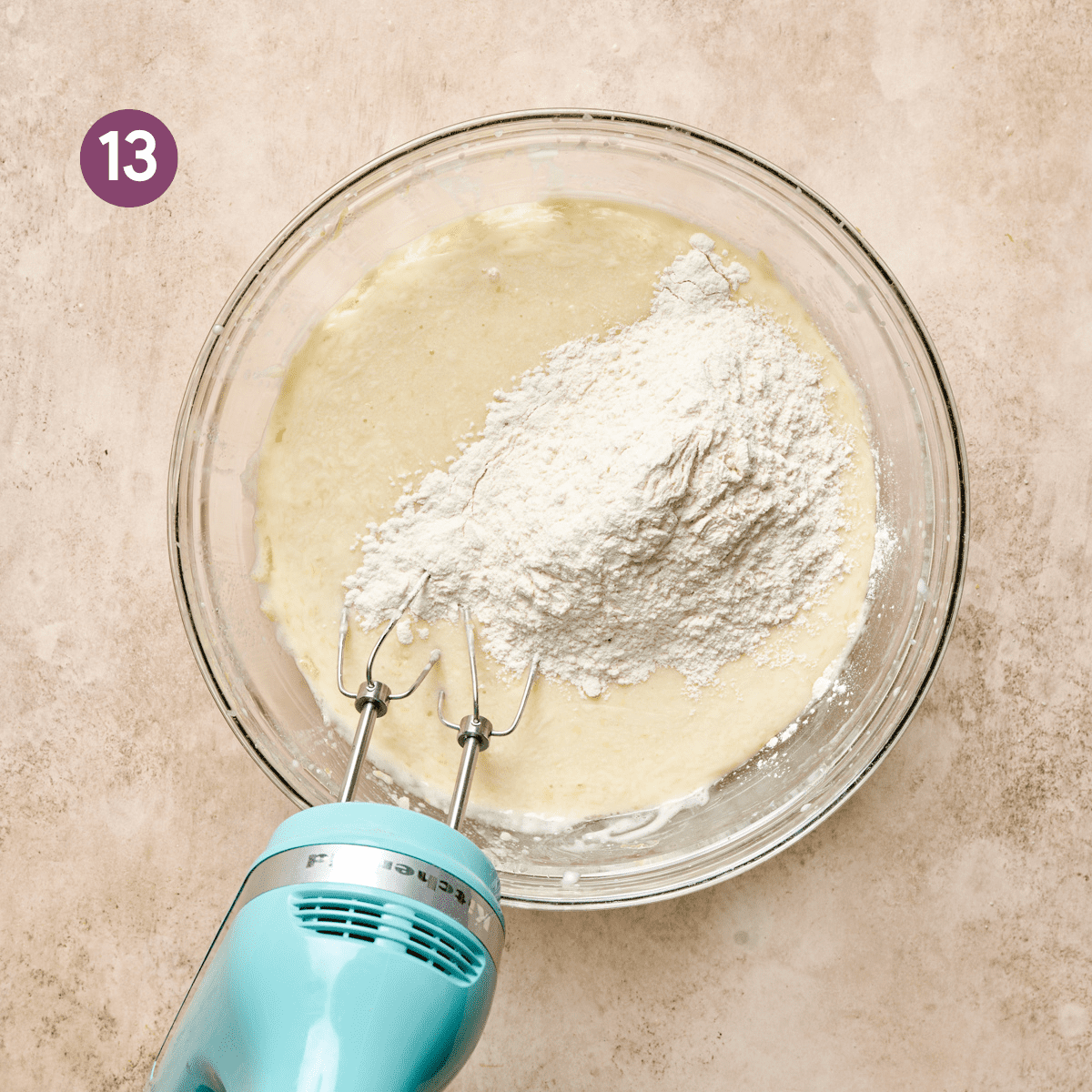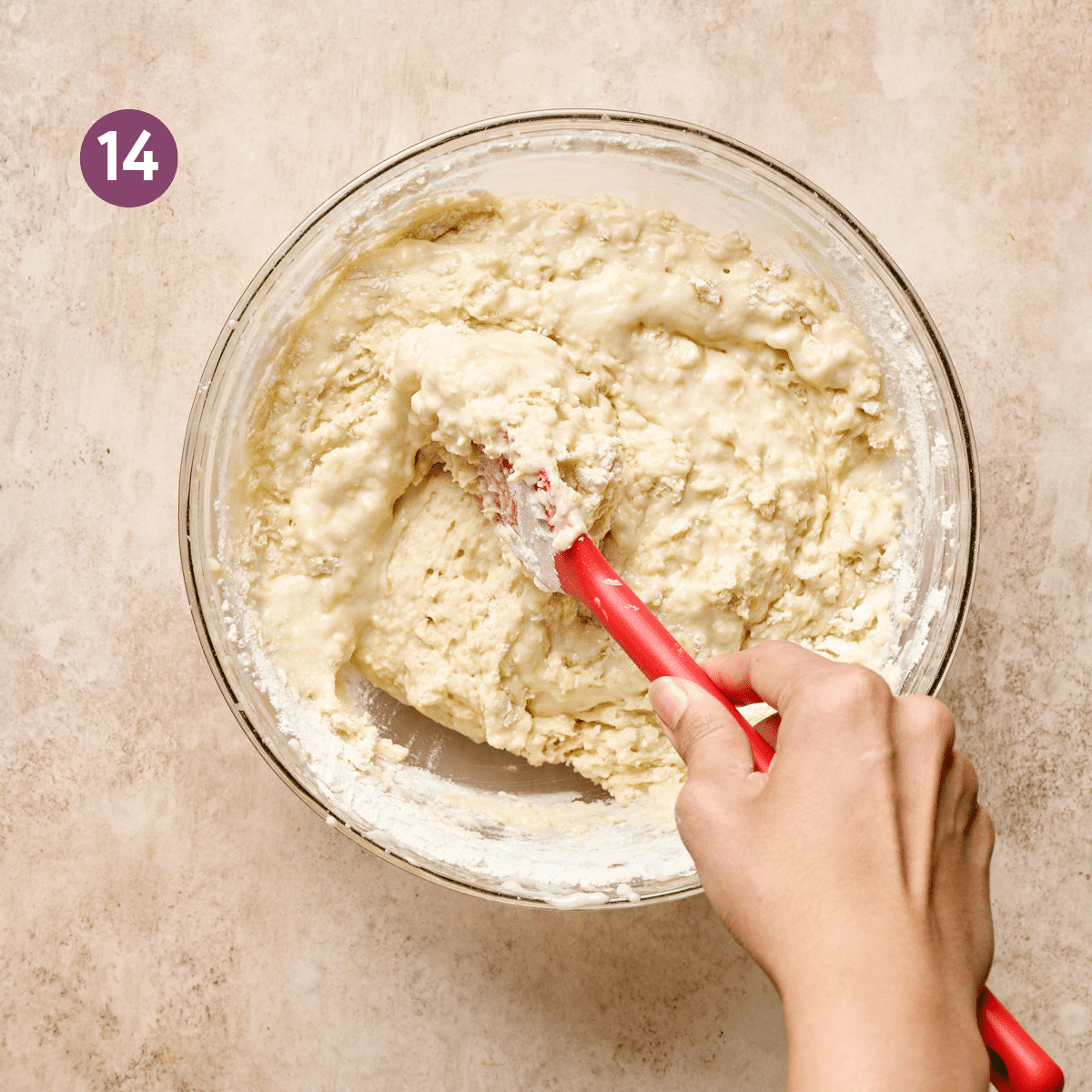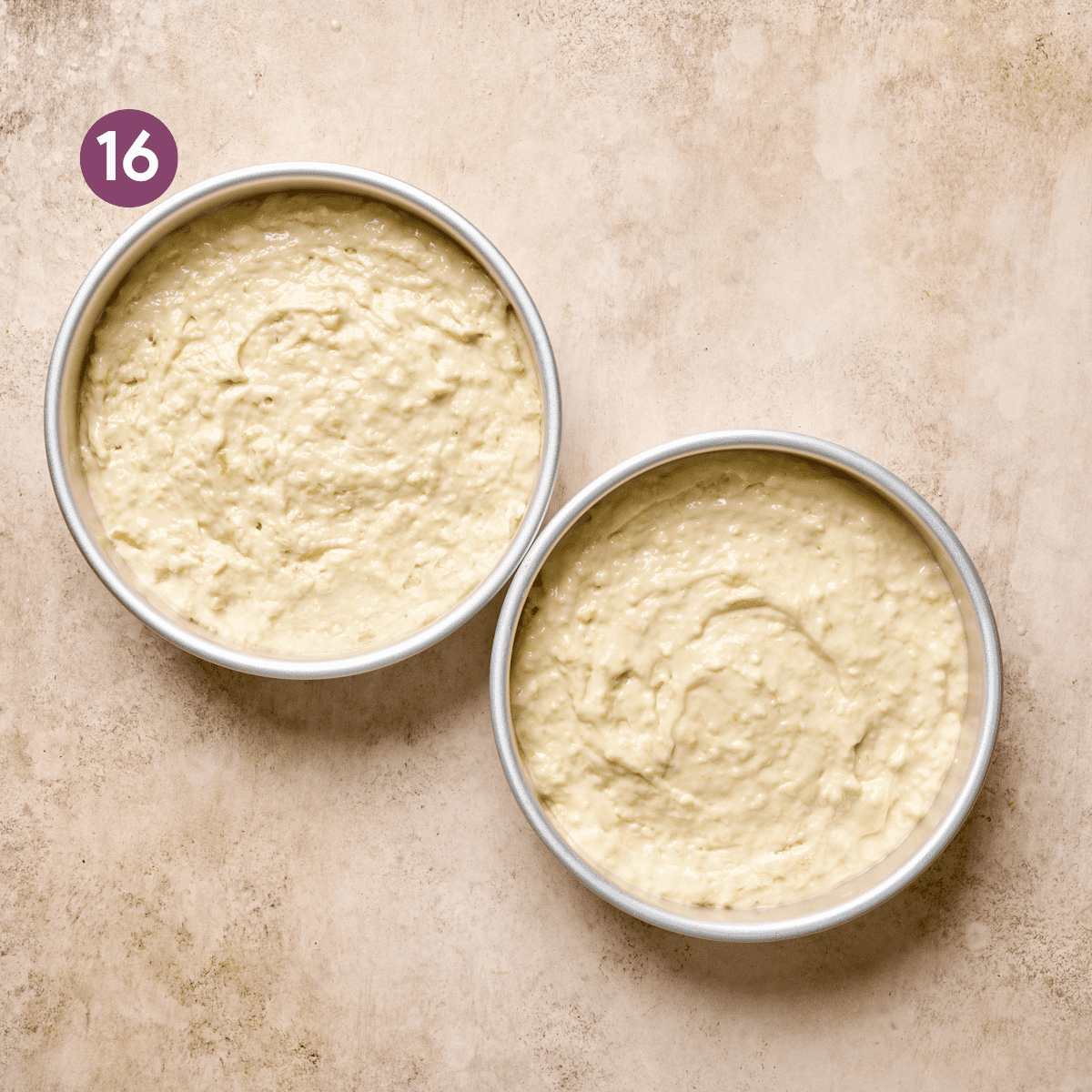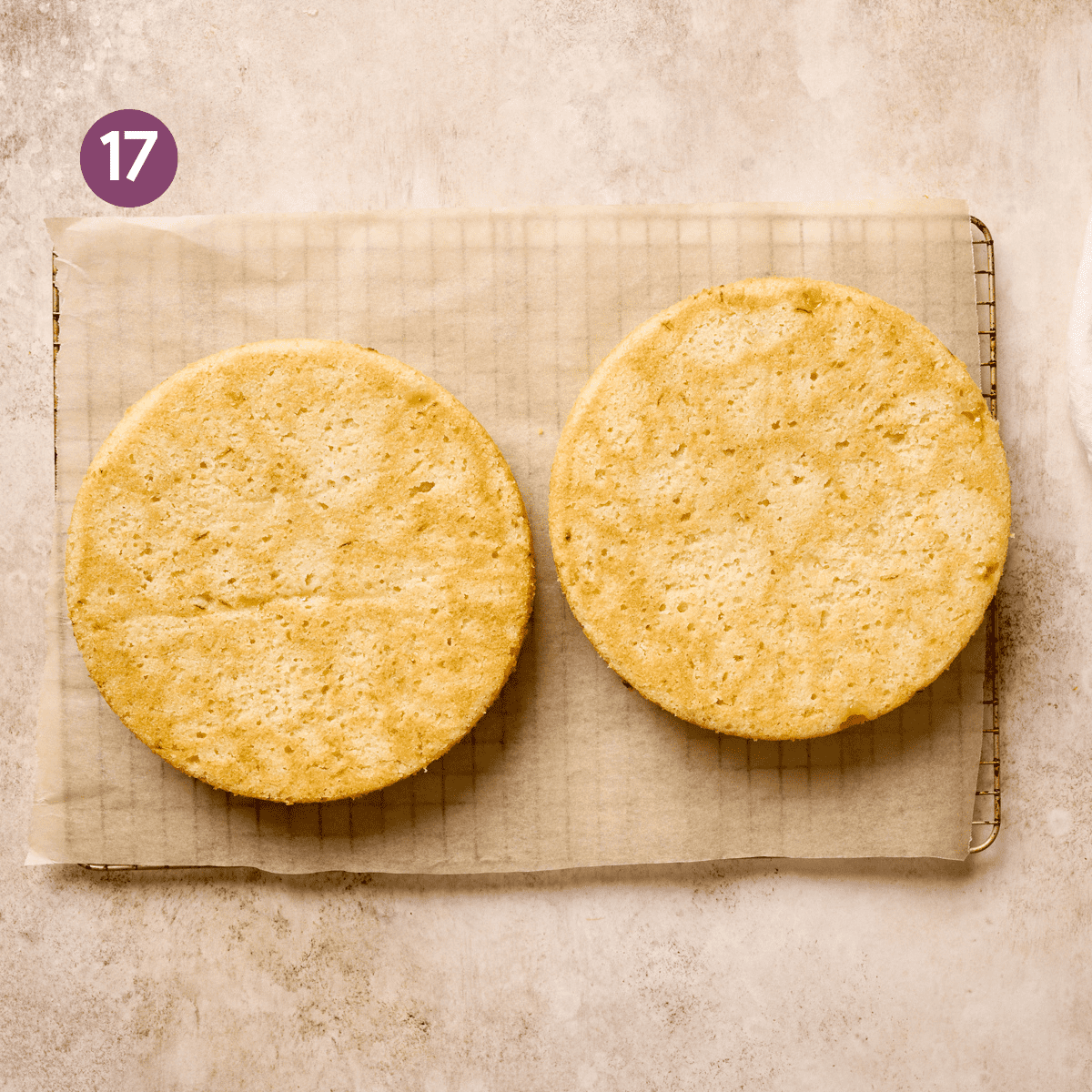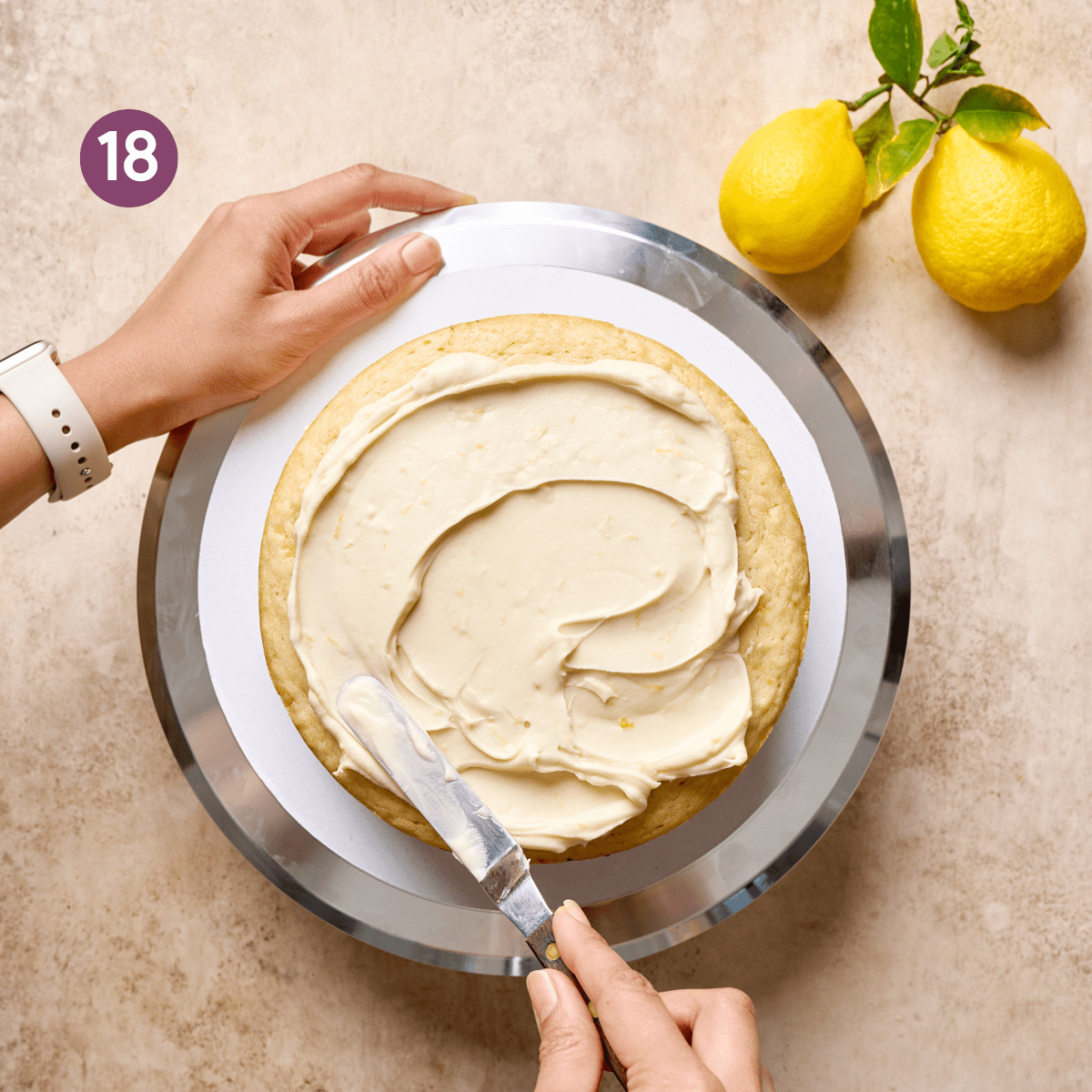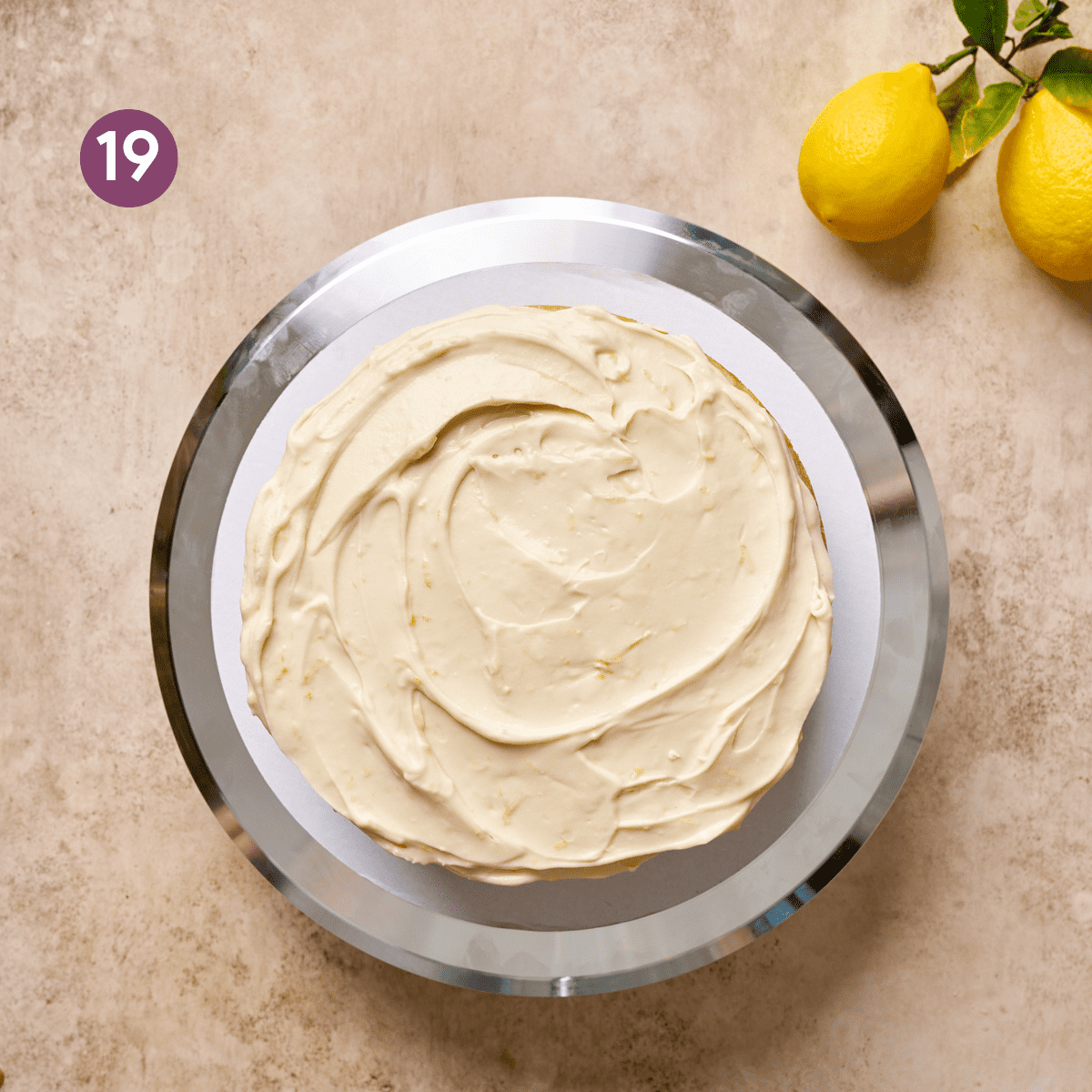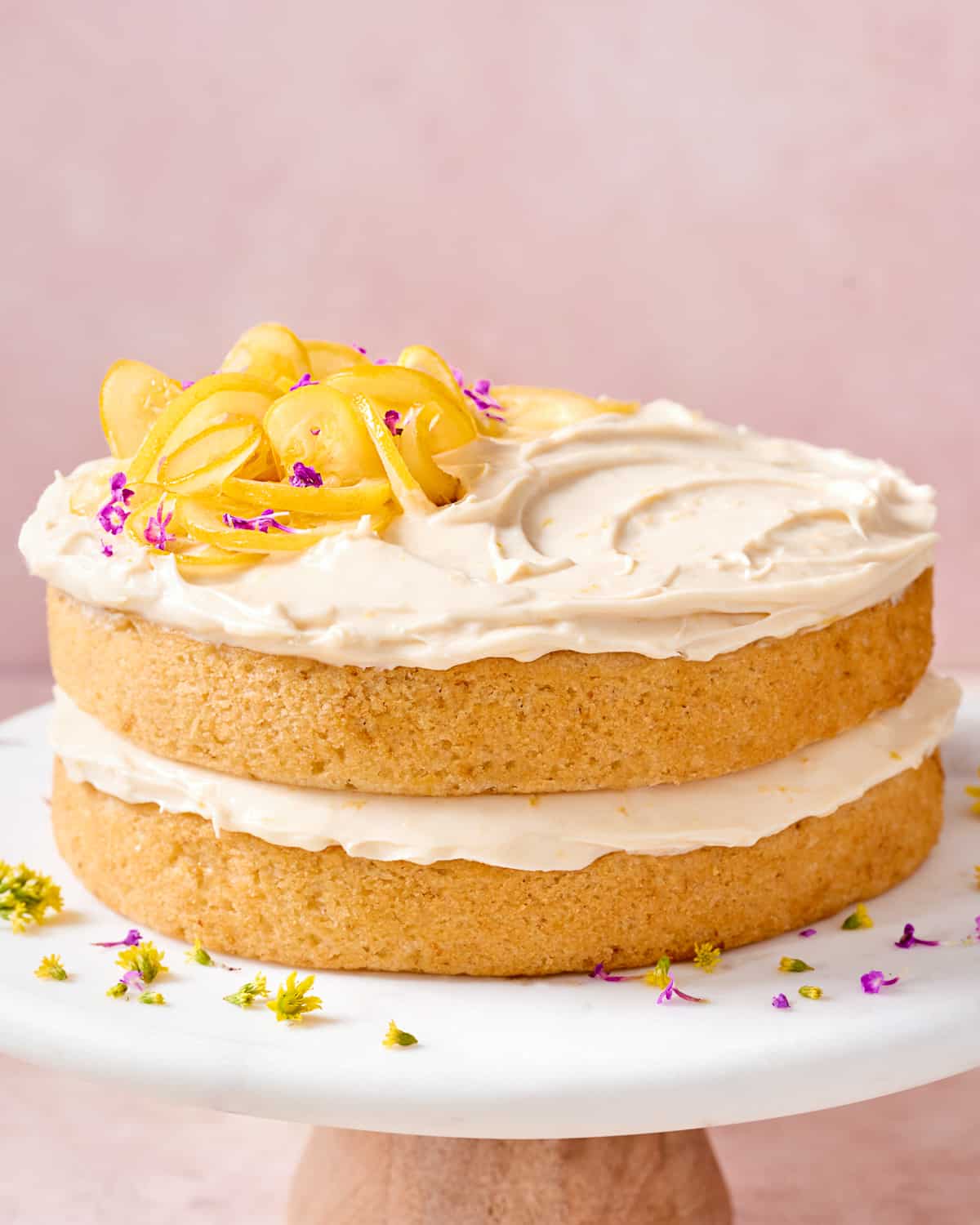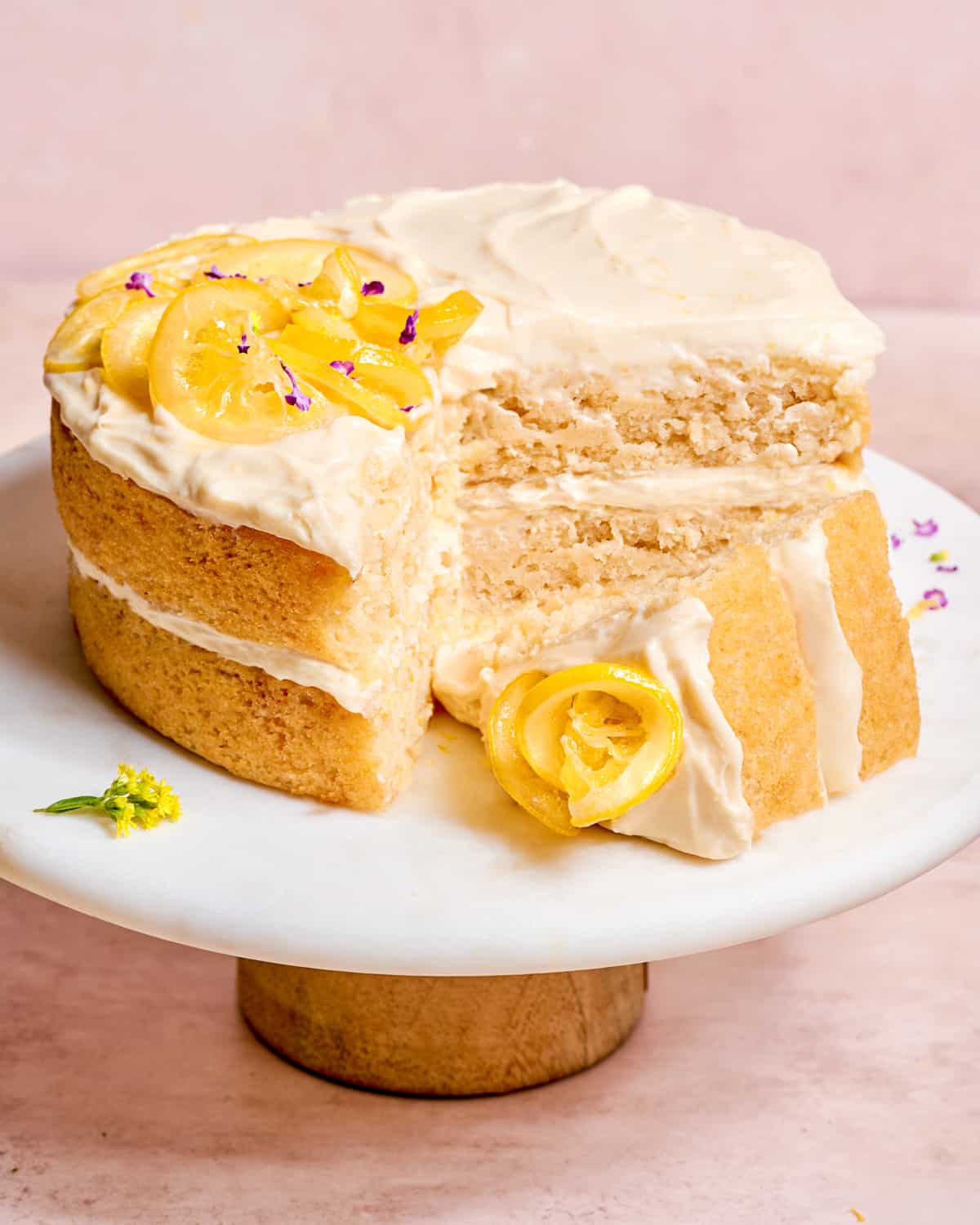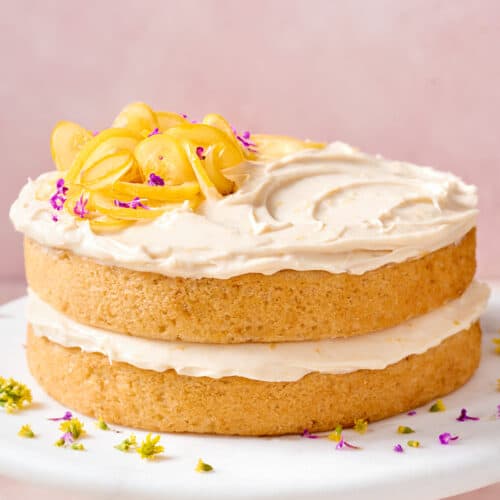A mixture of aquafaba and vegan sour cream lends the most tender, moist crumb and a melt-in-your-mouth texture that is so good you might actually cry. It’s topped with a tart, not-too-sweet lemon cream cheese icing that is outrageously delicious. It’s possibly the best cake I’ve ever made, and it is THE perfect cake to welcome spring, to celebrate birthdays, Mother’s Day, or anytime you’re in the mood for a special dessert. Table of Contents:1. Why this recipe works2. Ingredients3. Step-by-step instructions4. Tips for making this recipe5. Frequently asked questions6. Video: How to make this cake7. Recipe card
Why this recipe works
Made for lemon lovers.
The most disappointing thing about many lemon desserts is the mild lemon flavor, and many lemon cakes ditch lemon juice altogether and use lemon extract, but I wanted to bring the zingy flavor of real lemons to the table for this recipe. The problem is that adding a lot of lemon juice can screw up the texture of cakes, especially vegan cakes. In our first few tests, we added ¾ cup lemon juice. The flavor was amazing, but the texture was gummy and dense. This is because too much acid interrupts the development of gluten and can cause the cake to rise and then fall. Yet when we used less lemon juice, we could barely taste the lemon flavor. Solution: Use other parts of the lemon! Lots of lemon zest gets rubbed into the sugar to release its essential oils. Minced pieces of whole lemon and just enough lemon juice are also added for that zippy tartness. We use everything but the bitter white pith from the lemons. In reducing our food waste, we also cracked the code for the most amazing lemon flavor without compromising on texture. The frosting brings even more lemon flavor to the mix. It’s tangy from cream cheese, tart and zingy from lemon zest and juice, not too sweet, and wildly good!
Melt-in-your mouth texture
Thanks to lightly whipped aquafaba and vegan sour cream, the cake boasts a light and fluffy texture that literally melts in your mouth. It’s so soft and moist that it makes you close your eyes. Yes, it’s that kind of cake.
Gourmet but approachable.
This cake is easy to make and features basic ingredients like lemons, flour, sugar, and vanilla, but it’s so gourmet your guests will think it came from a fancy bakery. Plus, it freezes fantastically so no leftovers will go to waste!
Ingredient notes
Lemons (the whole thing!)
I always recommend using freshly squeezed lemon juice in cooking and baking because the flavor from the plastic bottles doesn’t compare, but it’s even more crucial when lemon is a key ingredient, as in lemon cake. Plus, you will need the zest and pieces of peeled lemon from fresh lemons. The zest adds its characteristic zippy floral notes, while the tiny pieces of lemon fruit add little bites of juicy and tart lemon flavor.
Vegan Sour Cream
This is one of the secrets to this vegan lemon cake’s fabulous texture. We found that replacing ½ cup of plant milk with sour cream did wonders. It added rich flavor and moisture, plus a more tender crumb that practically melts in your mouth. Tips for buying: We tested this recipe with two brands of vegan sour cream, Tofutti and Kite Hill with excellent results! Based on our experience with other recipes, we think Follow Your Heart sour cream would work great too.Substitute: We recommend sour cream for the best flavor and texture. If you don’t have access to it, you can probably use a good-quality vegan yogurt. Our favorites are Culina and Cocojune.
Aquafaba
Just the liquid from a can of chickpeas. As you might have learned from my fluffy vegan banana bread and chewy, fudgy brownies, it’s a great egg substitute in baking. Aquafaba is one of the primary methods for getting this vegan lemon cake so tender and light without having to rely on cake flour.
All-purpose flour
Speaking of flour, just everyday all-purpose flour works.
Vegan Butter
Adds that rich buttery flavor and a hint of saltiness to balance the sweetness. Substitute: If you don’t have access to vegan butter, you can just use more neutral-flavored oil. It won’t have the same flavor but the texture should not change too much.
Oat milk
Our preferred milk for most baked goods. In our experience, its neutral flavor and creamy texture work amazingly well, and the natural sugars in oats help brown baked goods more.
Step-by-step instructions
In a medium or large bowl, whisk together the flour, salt, baking powder, and baking soda.
Zest the 3 lemons using a microplane.
Now use a knife to remove the lemon peels and white pith (image 2).
Remove the lemon segments out of the white membranes (see the white bowl in image 3). Mince the lemon pieces (see the bottom right corner of image 3) and pick out the seeds.
Transfer the lemon pieces and accumulated juices to a strainer set over a bowl. Measure out 3 tablespoons lemon juice and keep that with the lemon pieces.
Add the sugar and lemon zest to a large bowl. Use your hands to massage the zest into the sugar until well incorporated and soft. Set aside.
In a small bowl, add the aquafaba. Whip on medium speed until foamy throughout.
Add the softened vegan butter and oil to the lemon zest-sugar bowl. Beat until starting to get fluffy and glossy, about 1 minute.
To the butter mixture, add the whipped aquafaba, vegan sour cream, milk, and vanilla. Mix on low until just combined. Finally add the lemon pieces and juice.
Mix again until the mixture is well blended. Add in half of the dry ingredients. Mix on low until just combined.
Use a silicone spatula to fold in the rest of the dry ingredients, taking care to not over mix. The batter should be fluffy and thick but airy.
Divide the cake batter between two (8-inch) round cake pans that have been lined and greased.
Bake in the oven at 350ºF/175ºC for 30 minutes. Allow cakes to fully cool on a wire rack. Refrigerate to make it easier to frost.
Once fully cooled, frost the cakes with the Lemon Cream Cheese Frosting.
Tips for making this recipe
Measure precisely!
You probably know this by now, but I’m a huge advocate for using a kitchen scale, especially for all baking purposes! It yields the most exact results and makes less of a mess as a bonus! If you don’t have a scale yet, be sure to use the spoon-and-level method when measuring flour. This prevents over-measuring flour, which can skew the final results in baking. Spoon your flour from the bag/jar into a measuring cup until full. Do not pack it down as you spoon it in. Then use a butter knife to level it off.
Room temperature ingredients
Allow the milk, sour cream and butter to come to room temperature. When combining these ingredients together, room temp ingredients bond together very easily since they’re warmer, creating an evenly textured batter. Doing this results in a beautiful fluffy and airy cake. Don’t skip this step or you’ll end up with a lumpy batter that doesn’t bake as nicely.
Prep everything before mixing.
Before combining the dry and wet ingredients, ensure everything else is ready (oven is preheated, cake pans are prepared). This is because the baking soda will start to leaven as soon as it’s mixed with the wet ingredients, so you want to capitalize on this leavening action.
Use a gentle touch when mixing.
First, add the dry ingredients to the wet ingredients in two stages. During the first mix, the dry ingredients get coated with some fat but not too much liquid, helping to weaken the gluten bonds (which leads to tenderness). During the second mix, the rest of the liquid is added, which helps to produce a light cake with an even rise. In contrast, if you were to add the dry ingredients all at once, you’d have to mix the batter more vigorously to incorporate. Vigorously beating a cake batter can lead to a dense texture and less fluffiness. Second, mix until the batter is just combined and then stop! The batter will be thick and fluffy. Don’t try to get it too smooth. I use an electric mixer which helps me from over-mixing, whereas a whisk requires more effort and is easier to overmix on accident.
For even cakes, use a scale.
If you have a scale, it’s easy to weigh the total amount of batter, then divide it between your two cake pans for the most even baking and presentation.
For the best frosting experience, chill first.
Room temperature cakes are annoyingly difficult to frost, so I recommend chilling the baked cakes and the lemon frosting simultaneously (at least 1 to 2 hours, or longer). This makes it much easier to ice the cake and prevents your cake from becoming crumbly. It also firms up the cream cheese frosting, allowing an easier spread. You can also make the frosting a few days ahead of time and store, covered, in the fridge.
Useful tools.
When making a layer cake, a few tools will come in handy (affiliate links).
Digital scale (for measuring ingredients + dividing cake batter evenly) Electric handheld mixer (or stand mixer) Two (8-inch / 20 cm) round cake pans Parchment paper for lining the cake pans Nonstick cooking spray or oil to grease the pans Small offset spatula for frosting the cake Cake stand, cake turntable, or Lazy Susan (to make it easy to frost the cake)
Frequently asked questions
More Special Occasion Vegan Desserts
Chocolate Mousse Brown Butter Peach Cobbler Apple Cinnamon Bundt Cake Vanilla Layer Cake
Video: How to Make Lemon Cake
Recipe: Nisha Vora / Rainbow Plant Life | Photography: Megan Morello
Zest. Use a microplane to zest the lemons. Peel. Now use a knife to remove the peel, including the white pith directly underneath the peel (it’s bitter, we don’t want it!). Segments. Peel the lemons with your hands into segments, similar to peeling oranges. Peel away the fibrous white membranes. You should be able to easily pull the lemon flesh out. Mince the lemon pieces into very small pieces. Strain. Put a strainer over a bowl. Pour the lemon pieces with accumulated juices over the strainer. Measure out up to ¼ cup (60mL) lemon juice from the bowl, and save the rest of the juice for another recipe (or lemon water). If any extra lemon juice accumulates from the lemon pieces, discard. You don’t want to add extra lemon juice.
Big Vegan Flavor
Techniques and 150 recipes to master vegan cooking.
